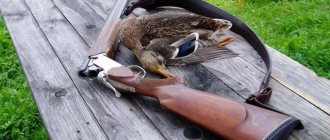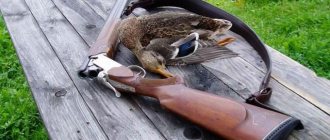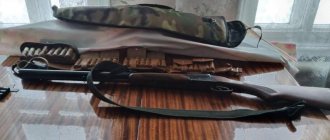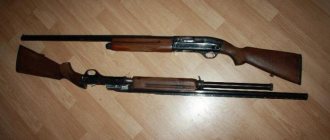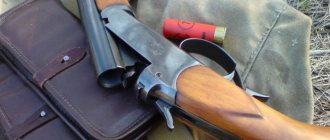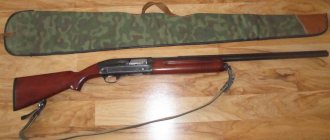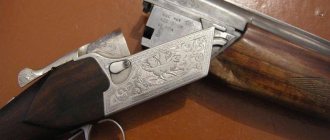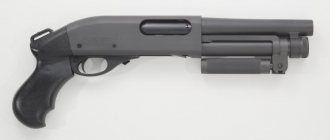The TOZ-63 shotgun is known to many hunters who have been using it for hunting for a long time or are trying to buy this model for themselves if they don’t have one.
The popularity of this model is primarily due to its combat qualities, durability and reliability. Every hunter wanted to have such a weapon during the years of the Soviet Union.
With it you can hunt any game and use not only shot, but also buckshot with a bullet. Such versatility is worth a lot, which is why many gun lovers wanted to have this example.
In the 60s of the twentieth century, the Tula Arms Plant needed to expand production and product range, so the decision was made to create the TOZ-63 gun.
In addition, at that time there was a TOZ-BM model in mass production, which they wanted to replace, but this did not happen immediately. Both models were produced over a period of time.
In 1964, the world saw the first model of this hunting rifle, which became a new product of Tula gunsmiths and won appreciation among hunters.
Getting to know the rifle unit
This model first appeared on the shelves of specialized stores in 1963. The double-barreled shotgun is available in 20 and 16 gauge. Every Soviet hunter dreamed of a TOZ-63 gun. The fact is that with the existing choke choke constrictions, the accuracy of the battle increased significantly and the shooting was no longer accompanied by unpleasant surprises. Judging by numerous consumer reviews, TOZ-63 16 caliber is in greatest demand. With this caliber it became possible to catch larger game. To keep the price of the rifle at the same level, these double-barreled guns are not decorated with expensive engravings at the factory. In addition, expensive types of wood are not used in the manufacture of stocks. However, according to experts, by special order the plant employees could produce several TOZ-63 16-caliber models.
Such rifle units had expensive nickel-plated blocks and were decorated with fairly high-quality engravings. The stock and butt of the TOZ-63 16 gauge in this case were made of walnut.
MC-21
One of the first semi-automatic rifles that was created in the USSR. MTs-21 is also the only domestic version of a self-loading weapon operating on the principle of a moving barrel. Used for commercial or amateur hunting. It has a tubular magazine on the fore-end that holds 4 rounds. The minimum combat accuracy is about 65% at a distance of 35 meters. When the bolt and barrel move backward, the internal hammer is cocked.
A fairly reliable model, which is most often used in regions with cold climates. Quite easy to disassemble and maintain. Does not require frequent lubrication. The barrel length is 750 millimeters. The weight of the weapon is 3.2 kilograms.
A little history
Until 1963, hunters had TOZ-B double-barreled shotguns manufactured in 1902. In 1957, it became clear that these rifle units were already outdated.
From this time begins the history of guns, which today are known as TOZ-63. During modernization in the early 1960s, a model appeared, which in the technical documentation was listed as TOZ-BM. The base for it was the TOZ-B double-barreled shotgun. In the new weapons, the barrels are made of higher quality weapon steel, which has a positive effect on the “survivability” of the gun. A couple of years later, the designers of the Tula arms plant TOZ-BM decided to update it. The result was the TOZ-63 16-caliber model. Initially they were going to replace the TOZ-BM with it. However, the Soviet government demanded to expand the range of small arms.
Therefore, they did not abandon the TOZ-BM and continued to produce it simultaneously with the TOZ 63 model of 16 caliber. According to experts, both models were almost identical. Since they are of the same caliber, in order to somehow distinguish them, the manufacturer decided to chrome-plate the barrel channels and chambers in the TOZ-63 16-gauge shotguns.
MP-43
The main distinguishing feature of the MP-43 (IZH-43) from the IZH-58 and its modifications is the universal double-trigger trigger mechanism. That is, the hunter can shoot both in autonomous and single-trigger mode. This model has received a more ergonomic shape, and recent releases have shown that the manufacturer has improved the build quality and began to process the metal better. IZH-43 is highly reliable and forgives most of the mistakes that beginners make. That is why this weapon is so loved by novice hunters.
About the design
The gun is represented by the following elements:
- Two detachable trunks located horizontally. For this reason, TOZ-63 shotguns are also called “horizontal guns”.
- High-quality chrome-plated barrel channels with different choke constrictions, which had a positive effect on the accuracy of fire.
- Mainsprings, which are cocked by combat hammers. Judging by the reviews of the owners, the double-barreled shotgun can be put into combat readiness in a couple of seconds.
- Ejector. It is common to two trunks. Responsible for the extraction of spent cartridges.
- A removable forend, which is fixed with a lever latch.
Mostly stocks are made of birch. For improved modifications, the manufacturer can use beech or walnut.
Recommendations for selection
Regardless of caliber or brand, any weapon must have good technical characteristics. Here's what you should pay special attention to when purchasing:
- Adaptability is an indicator of the weapon’s suitability for the shooter’s physique. You will not find it in any gun passport, but you can and should ask the seller to give you the weapon in your hands to evaluate this parameter. Raise your gun and aim it at some target. The barrel of the “wrong” gun will lie below or above the target, or will simply point to the side. Most often this is due to the fact that the weapon is too heavy for the hunter. This leads to misses and wasting extra time aiming.
- Balance. To find balance, you need to balance the gun. The weapon has good balance if the breech end of the barrels is located at a distance of about 70 millimeters from the center of gravity. Balance is also determined by weighing the gun with and without a forend. The ideal mass ratio is 2:2.2.
- Posadism. The mass of good weapons is concentrated in the middle part. If you take it in your hands, the end of the barrel and the butt will be much lighter. Otherwise, the aiming process can become very difficult. It will also be much harder for the shooter to raise the gun.
When choosing a weapon, pay attention not only to the technical characteristics and reviews of the model, but also to your feelings while working with the unit. The legendary sixteenth caliber was loved by hunters for a reason. Such weapons have good accuracy of fire combined with great destructive power. A universal and almost ideal gun for any hunt.
About trunks
TOZ-63 rifle units have solid-drawn barrels. According to experts, manufacturers have not used this technology for a long time in the manufacture of hunting weapons, since it is too labor-intensive and expensive. Its essence is that one blank is taken to produce the barrel and chamber. Today, all guns produced at the Tula Arms Plant are equipped with a chamber and barrel made from different parts. A special coupling is used to connect them to each other. If we compare this design with a solid-drawn barrel, then, according to experts, it is less reliable.
Also in this section:
Double-barreled hunting shotgun TOZ-66
01.01.1970
Section: "Directory"
Excerpts from the passport of the double-barreled shotgun TOZ-66
Read →
About the device
TOZ-63 with triple locking barrels. Today, this system is no longer used by many manufacturers of hunting weapons. The developers felt that it was too labor-intensive. By eliminating triple locking, manufacturers are able to increase productivity. However, this system is available in the TOZ-63 model. The barrel in the closed position is fixed with two under-barrel hooks and a Greener bolt. Due to the fact that during shooting the load is distributed across three elements, each of them ultimately has an increased service life. This explains why the barrels in the TOZ-63 are not loose. This defect, judging by the reviews of hunters, is very common in old double-barreled shotguns. Each of the barrels is equipped with a trigger mechanism, which the manufacturer placed on a separate base.
Judging by the reviews, the most powerful mainsprings break the toughest igniters. If we compare Soviet-made capsules with modern ones, the latter are much thinner. For this reason, they penetrate through the strikers.
MAKSIMOV.SU
Hunters are one of the most conservative segments of society.
This can be confirmed by the unfading popularity of classic designs of hunting weapons, which have a history of more than a century. In Russia, a country with harsh climatic conditions and difficult historical developments, the conservatism of hunters and gunsmiths was rather forced.
Back at the beginning of the twentieth century, in the era of automatic weapons chambered for a unitary cartridge, Russian hunters were distrustful of breech-loading weapons and made do with ramrod systems with impact locks. It was with a focus on the traditional ideas of the Russian hunting community that mass production of the breech-loading classic double-barreled shotgun began with a hammer-operated model.
A pre-revolutionary TOZ-B shotgun,
once owned by the famous publicist and translator A.N. Aksakov
Historical reference
In the Russian Empire, the production of hunting weapons was traditionally carried out by single artisans, small workshops or private factories, which could not provide a huge army of hunters with weapons in the required quantity and quality. Despite mandatory factory testing of handicraft guns, craftsmen did not always follow the law.
Accordingly, no one could guarantee the hunter sufficient strength of the gun, and the low price did not particularly oblige him to do so. The problem of an acute shortage of high-quality guns was a consequence of the need to provide a huge army with small arms, constant wars and frequent rearmament in the second half of the 19th century.
All attempts to establish the production of hunting weapons at state-owned arms factories were constantly frustrated due to government orders for the production of army small arms. And in factories, the production of hunting rifles was extremely low-tech due to the dominant share of manual labor.
ITOZ branding on the interbarrel strip
of a pre-revolutionary “tulka”
At the beginning of the twentieth century, the Imperial Tula Arms Factory, thanks to a sharp decrease in orders for the production of the Mosin rifle, was able to load the freed production capacity with the fabrication of hunting weapons. It was the well-established machine production of guns, with a maximum reduction in the share of manual labor, that could become the key to the mass production of high-quality weapons at an affordable price.
A major role in the development of industrial production of classic hunting weapons was played by ITOZ engineer Sergei Aleksandrovich Zybin, who, while studying at the Mikhailovsky Artillery Academy, was on the same student bench as the creator of the legendary “three-line” Sergei Ivanovich Mosin.
After graduating from the academy, former classmates worked together at the Tula plant. S.I. Mosin was organizing the production of his rifle, and S.A. Zybin was in charge of the production of hunting weapons. At the end of the 19th century, ITOZ masters were already producing trigger “horizontal guns,” but in extremely small quantities and almost entirely by hand.
In 1901, the Tula plant took active steps to resolve the issue of choosing the type of hunting weapon and optimizing the process of machine production of guns. The question was far from idle, the matter was new, so it was decided to use ready-made solutions and use the experience of foreign gunsmiths.
And a completely logical step for the plant’s management was Sergei Zybin’s business trip to developed European countries.
Returning from the trip, Zybin, having analyzed and summarized foreign experience, proposed organizing the production of hunting weapons, taking into account the developments of foreign colleagues, in particular Belgian gunsmiths. "Tulka" Aksakov
It should be noted that all proposals about the type of future mass-produced hunting rifle were actively discussed on the pages of hunting periodicals of that time. Participation in discussions by such authorities as S. Buturlin and A. Ivashentsev, in addition to factory engineers and designers, made it possible to determine the optimal type of hunting rifle that suits everyone - an inexpensive, durable, elegant classic double-barreled shotgun with external hammers, preserving the features of a ramrod shotgun.
The most difficult task set - to create a high-quality and inexpensive gun at a domestic factory, using domestic materials, equipment and the labor of Russian craftsmen - was brilliantly accomplished.
The first release of the Model B occurred at the end of 1902. A year later, mass production of this gun began, which continued until 1956, with interruptions during the Civil and World War II. Due to the inevitability of the outbreak of war and the complete transition to military government orders, at the beginning of 1941 the plant transferred the production of hunting weapons to one of the Tula arms artels.
From February to July 1941, the Volodarsky artel was engaged in assembling guns from components produced by TOZ. The guns of this artel were branded with an oval brand with the letters “AimV. Tula" in the center and, released in quantities of only a few thousand copies, taking into account natural losses and confiscations during wartime, are now a rare occurrence, especially in good preservation.
Rare “tulka” (TOZ-B) assembled by the Volodarsky artel, 1941. Photo by Alexey Krivosheev
Tula "triggers" were produced in several versions. In addition to the most common modification TOZ-B, which has a classic backing lock, guns with “Liege” locks and with “neck” locks were produced in small quantities. The latest modification of the “trigger” was the cheapest and did not have an upper locking unit.
Familiar to all domestic hunters, the modification of the “tulka” - “TOZ-B” with padlocks, is a classic example of a hunting weapon - a “perelomka” with horizontally located barrels, with triple locking (on 2 under-barrel hooks with a Perdet frame and a transverse Griner bolt), with padlocks locks on the side boards and external triggers.
The mark of the artel named after Volodarsky. Photo by Alexey Krivosheev
To unlock the bolt, a top key designed by Westley Richards is used. The hammers have a release, are made separately from the spring-loaded firing pins, the forend is detachable, English type, with a spring push-button latch. The combat leaf springs of the locks are V-shaped and are inflated when the hammers are manually cocked.
The trigger mechanism has 2 triggers and is mounted on a separate common base. The cartridges are pulled out by an extractor when the barrels are broken. The caliber of the “imperial” “tulkas” was mainly 12 gauge, but guns of 16 and 20 gauge were also produced. Chokes: cylinder-choke or (to order) - choke-half. The barrels are brazed, with a guilloche rib. The chambers are usually chambered for a 70 mm folder sleeve. The stock is walnut, semi-pistol or straight. Classic swivels.
TOZ-B shotgun, general view
The cost of guns varied from 33 to 80 rubles, depending on the finish. Cheap guns were decorated with “colored paper” and simple engraving, expensive guns were blued and decorated with gold notching. One of the distinctive features of the exterior of pre-revolutionary shotguns was the rudimentary ridges on the sides of the block, located in front of the hammers, below the firing pin nut - a legacy of the percussion lock, in which the ridge served a protective function in case of rupture of the primer.
TOZ-B piece gun
The manufacturing quality of the guns was high; the guns were very popular due to the adequate price-quality ratio and excellent performance characteristics. A notable sign of the good reputation of the “imperial” trigger “tulkas” are the numerous cases of counterfeits in the post-war years. The starting material for creating the “royal” gun was cheap Tula hammers produced in the Soviet era, which, after very professional “tuning,” turned into truly beautiful guns.
Shotguns TOZ-BM and TOZ-63
close-up
Under Soviet rule, production of TOZ-B was restored after the Civil War. From 1922 to 1932 The gun was produced, with rare exceptions, only in 16 gauge. After 1932, 20 and 12 caliber shotguns went into production. The weight of 16-gauge shotguns varied from 700 to 725 mm, weight - in the range of 3-3.25 kg. In 1957, TOZ-B was modified. The new model became known as TOZ-BM and was distinguished by increased barrel strength. The caliber of the guns produced is 16th and 20th.
TOZ-BM and TOZ-63 with open barrels, right view
Since 1964, the “tulku” began to be produced under the symbol TOZ-63. It differs from the previous model only in chrome-plated barrels and improved finishing. TOZ-63 was produced in 16 and 20 calibers. It should be noted that TOZ-B models from the 60s with chrome-plated barrels are quite common.
TOZ-63 with broken barrels. The right trigger screw has been replaced
The 12-gauge Tulka was produced from 1968 to 1974. under the symbol TOZ-66 and had chrome-plated barrels with a reinforced receiver. This model is still considered the best of the Tula triggers.
For fishermen, “tulki” of 28 and 32 calibers were produced, with the TOZ-50 index and a weight of 2.6-2.8 kg with 720 mm barrels.
These models are very rare today and are of no interest to most amateur hunters. From 1974 to 1978 a modification of the TOZ-54 was produced, differing from the TOZ-BM in its production technology and ugly “ultra-modern” angular shapes, which were negatively perceived by hunters accustomed to the smooth lines of the classic “tulka”. TOZ-BM and TOZ-63, both 16 gauge guns
In 1978, TOZ stopped producing the trigger “tulka”. Its production was restored only in 1986 under the symbol TOZ-80 and continued until 1990. The technical characteristics and external shape of the gun are identical to TOZ-BM and TOZ-66. Only the outlines of the fore-end have changed. Caliber - only 12th. Currently, Tula trigger guns, unfortunately, are not produced.
Since 1902, the Imperial Tula Armory (Anson design) also produced a hammerless “tulka”. In the USSR, this hammerless gun was produced from 1922 to 1955, with a break in 1941-1944. Model “A” also had the classic triple locking - on the Perde frame and the top Griner bolt.
The first releases of guns had hammers made integral with the firing pins (later, in the 1930s, they became separate), lower sears and plate mainsprings lying in front of the hammers, in the grooves of the pads. Model "A" had an automatic safety locking the triggers and sear. Caliber - 20th, 16th and 12th. The cost of hammerless guns, produced in small quantities, significantly exceeded the cost of trigger guns, reaching 100-170 rubles.
Differences in the shape of the trigger of the TOZ-63 and TOZ-54 shotguns
“Model A” was also produced in a version with removable locks. Only a few hundred copies of these guns were produced (according to other sources - less than a hundred pieces). The design of these locks was proposed by the now famous designers V. Anson and D. Dili of England.
Locks of a simple design, consisting of only 7 parts, required, however, the perfect fit of all parts, which required a very highly qualified craftsman. Therefore, only the well-known and Lebo-Kurali locks risked being installed on their guns with removable Anson-Delay locks.
Based on this alone, one cannot underestimate the fact that the production of hammerless guns with removable Anson-Delay locks was established at the Tula plant - the qualifications of Russian craftsmen and the performance of domestic guns were at the world level.
It is appropriate to remember here that the Izhevsk Arms Plant at the very beginning of the 1900s also produced excellent-quality trigger “horizontal guns” with padlocks, in significant quantities and in various designs, with double and triple locking.
Today, Izhevsk trigger guns of the pre-revolutionary era have been undeservedly forgotten, but only because their production ceased during the years of Soviet power. There are not many of these guns left, probably even fewer than the “imperial” “tulkas”.
The epitome of a classic
Russian weapons have always been famous for their unsurpassed combination of reasonable prices and good performance characteristics that completely satisfied our hunters. Tula "triggers" perfectly performed the difficult tasks assigned to them in all climatic zones of the vast expanses of our Empire.
And the fact that the “tulkas” were forced to compensate for the lack of hunting weapons along with the alterations of the military systems of Berdan, Mosin, Krynka and foreign systems is explained, first of all, not so much by the backwardness of the country, but by the need to first provide weapons to a huge army to protect equally large territories. Add here the harsh climatic conditions, which in our time are a kind of factor in the natural selection of fishing weapons.
Difficult operating conditions empirically revealed the fact, which was unpleasant for adherents of “proper hunting”, that “guns for royal hunting” were not suitable for commercial use.
Therefore, the demand for civilian modifications of army weapons in Russia today is as great as it was 100 years ago. Locks, from top to bottom - TOZ-BM, TOZ-63 Note the different shapes of the triggers
And there is no need to look for the reasons for this only in the mentality of the nation, because the dominant factor here is the climate, our harsh continental climate, which will always influence our weapons, the cultural and psychological genotype of the people, and, for that matter, the economy.
TOZ "triggers", in addition to reliability and good combat, also have such important characteristics as moderate weight and adaptability, characteristic of classic hunting weapons. A characteristic feature of the "tulka" - external triggers - gives the weapon a special charm.
When you visually compare the Tula ramrod capsule gun of the late 19th century with the TOZ-B, you are surprised at the layout similarity of two guns, so different in design. And then it becomes clear that the external triggers of the TOZ-B were left by inertia, as a tribute to tradition, for supporters of the “correct hunting” of those times.
Moreover, the hammerless gun was patented by V. Anson and D. Deeley back in 1875. But hunting traditions are unprecedentedly conservative and therefore double-barreled shotguns, even after more than a hundred years, are not much different from each other. The only differences are in the production technology and materials used.
Shotguns with external hammers, compared to non-hammered ones, have several advantages: although a hammer-driven shotgun does not have a safety lock, a loaded shotgun with the triggers pulled can be stored indefinitely without the risk of the mainsprings being loosened (analogous to revolvers or pistols with an external hammer). The triggers, if necessary, can be cocked and released absolutely silently by manipulating the trigger. If there is no need for a second shot, then it is enough to cock only one hammer of the desired barrel.
Shotgun block TOZ-BM
and lock assembly
We hold it in our hands
“Tulka” is simply and easily disassembled for transportation and cleaning, unpretentious and easy to maintain. The traditional rib and brass front sight are convenient, especially when shooting offhand. The bar has anti-reflective knurling. To improve the accuracy of bullet shooting, some hunters solder a homemade rear sight into the transverse groove of the bar.
Although the optimal solution to this problem, in particular cases, would be a lifting universal rear sight, modeled on the European combined “tees”, although its presence on a smooth-bore double-barreled shotgun is a rather dubious advantage.
The stock on ordinary examples of the “tulka” is not entirely ideal, but it also does not cause any particular complaints. On the back of the butt were either brown or blued plastic butt plates made of stamped metal, as befits a classic gun. Thanks to the light weight and relatively comfortable recoil of the 16-gauge, these guns have always been eagerly used by hunters, teenagers, women and older hunters.
Cocking the hammers may require some force. The trigger stroke, as expected, is short and without idling. Both triggers are spring loaded.
Of course, not all “tulki” produced in the Soviet period are distinguished by high-quality finishing and impeccable combat.
Not at all. Sometimes you come across guns with frankly poor filing and fit, with disgusting combat. The Greener bolt's locking application requires highly skilled gun assembly. TOZ-BM disassembled
Otherwise, it simply will not perform its function. It was not for nothing that Izhevsk at one time abandoned the Greener cross bolt, starting with the Izh-58 model. On many “tools” the fit of the upper locking unit does not stand up to criticism. Processing and debugging of other parts and assemblies also sometimes causes well-deserved criticism. Often ordinary guns have poor metal-to-wood fit. Old guns can be dangerous due to wear and tear on the safety cock.
Tula trunks are usually traditionally quite good, but the “baptism” of STP and the behavior of trunks on ordinary late “tulkas” is not such a rare phenomenon. However, there is nothing particularly surprising here - an ordinary “horned” “tulka” in the 70s cost about 60-70 rubles, was an ordinary consumer product, but, nevertheless, fully met the simple requirements of the bulk of amateur hunters and fishermen. On the periphery, the tulka, despite its 3 million circulation, was generally a scarce commodity, despite all its pros and cons, remaining a desirable gun.
TOZ-B shotgun,
bottom view
It can be argued that the “horned” Tula horizontal is an ideal gun not only for “proper” hunters, but also for poachers, “survivalists”, bandits and other “partisans”, as well as as the main weapon for rangers, foresters and game wardens.
Why? Yes, judge for yourself: a well-thought-out and time-tested design, excellent maintainability (screw fastening of the gun structure, locks on the side boards, the high prevalence of “knuckles”, which implies the easy availability of spare parts for repairs), ease of transportation when disassembled, reliability and durability of the gun.
Plus to this: the absence of a traditional safety, the possibility of absolutely silent loading, reloading the gun and the same silent bringing into battle. The gun can be stored loaded for an unlimited time, with the hammers pulled, and the ability to cock the hammer of the desired barrel is sometimes also a necessary feature. Whatever one may say, the “tulka” is an extremely successful and well-deserved gun still beloved by many Russian hunters...
TOZ-BM,
the right trigger was replaced with a trigger from TOZ-63
Technical characteristics
of the TOZ-63 model
To illustrate the material in this article, the TOZ-63 shotgun, manufactured in 1970, was chosen to illustrate the material. Caliber 16?70. The barrels are chrome-plated, which is more than essential for a working hunting rifle. The chambers are for a folder sleeve (it should be noted that to reduce the cost of a shot, brass sleeves were used almost everywhere by hunters, which, contrary to popular belief, reduces the effectiveness of a shot by no more than 10-15%, which is not significant for commercial hunting).
The following stamps are stamped on the barrel coupling cushions: year of assembly, stamps of permissible pressure in the chambers (up to 700 atm), stamps of choke constrictions (“choke” and “poluchok”), stamps of testing with reinforced charges of nitro-powder, shooting for accuracy, caliber designation (16x70 ), type of drill (stamp “boom” - for a paper or plastic sleeve), as well as the series and number of the gun.
The weight of the described specimen is 3.2 kg, the total length is 1165 mm, the length of the barrels is 725 mm, the distance from the rear trigger to the heel of the butt is 365 mm, to the toe of the butt is 370 mm.
Center distance in the treasury - 27.4 mm, center distance in the muzzle - 17.5 mm, overall height of the block on the shield - 55 mm, height of the shield - 28.5 mm, overall width of the block - 55.5 mm, width of the block under the shield – 38.1 mm. The beauty and grace of the triggers of Tula double-barreled guns
The distance between the holes for the strikers is 28 mm. The outer diameter of the barrels at the muzzle is 19.9 mm, in the treasury - 27.8 mm. The internal diameter of the barrels in the chambers is 18.9 mm, in the muzzle - 15.9 (right barrel) and 15.7 (left barrel). The distance between the supporting surfaces of the under-barrel hooks is 50.5 mm.
The butt has a small, almost imperceptible deviation to the right; the cheekbone is missing. The loss of the stock in the comb is 35 mm, in the heel of the butt - 50 mm, which is the average for a stock made on a copier. The fit of the metal into the wood is not bad, but the wood of the stock has a lot of overhang. The pitch value is 55mm down.
The described gun has a very large shot of clearly exorbitant charges, which results in significant horizontal and vertical looseness of the barrels.
Conclusion
Trigger guns of any modification are simple in design, lightweight, reliable, beautiful and durable weapons, a true embodiment of the classics. "Tsentralki" 12, 16 and 20 calibers are suitable for any hunting using shotgun, buckshot and bullet cartridges in any natural zone of Russia, which, together with good fighting and reliability, has become the reason for their great popularity.
External triggers are a controversial design choice, but they evoke memories of the charming old cap-lock muzzle-loading shotguns, bringing to mind the historical hunting scenes we all loved from childhood in books and movies.
It is for the opportunity to escape, at least for a short time, from the city frenzy and noise and plunge into the peaceful silence of the wild that we so love short hunting moments. And the old father’s or grandfather’s “tulka” with its graceful, antique-style smooth outlines is perfectly suited for mental relaxation, turning the banal extermination of living creatures into a sacred act, which from time immemorial has been passionately loved by both kings and peasants - Her Majesty the HUNT...
Tula trigger -
a real hunting classic
The article was published
in the magazine "Hunting"
Owners' opinion
Judging by numerous reviews from hunters, TOZ-63 shotguns have the following strengths:
- Double-barreled shotguns are very reliable. In addition, they are equipped with a trigger mechanism that is easy to maintain.
- These “horizontal guns” have an accurate and sharp combat. Experts recommend loading the left barrel with shot, and the right barrel with a bullet.
- The owners highly appreciate the presence of high-quality chrome plating in the barrel channels.
Despite the presence of undeniable advantages, these guns are not without some disadvantages. For example, some owners are not satisfied with the quality of fit of the mechanisms. Often, hunters have to modify their guns themselves. There are also complaints regarding the neck of the stock. It is quite thin and can break if you shoot powerful ammunition or handle the weapon carelessly. In this case, experts advise installing a stock with a thicker neck on the double-barreled shotgun.
How to disassemble the “horizontal”?
If you need to clean the gun, you first need to disassemble it. Before starting, the weapon is unloaded. First, the forend is separated from the barrel. Then you need to separate the trunks. The gun should be held with your right hand in the neck of the stock. Next, use your thumb to move the locking lever to the right until it is completely in its extreme position. Now the trunks can be separated by turning them down.
To remove the impact mechanisms, it is necessary to remove the screws holding them in place. After completing these steps, partial disassembly is complete. The double-barreled shotgun is assembled in the reverse order. If you need to do a complete disassembly, experts do not recommend doing it at home. It is more advisable to take the weapon to a specialized workshop.
What is 16 gauge?
To answer this question, you first need to understand that gun barrels can be made using a smooth or rifled cylinder. In smoothbore guns, the muzzle towards the end of the bore may taper or be permanently straight. Determining the caliber is not that difficult. In smoothbore guns, it depends on how many lead bullets of the same mass (about 453.6 grams) can fit in the barrel at a time. In this case, the diameter of the bullet must necessarily correspond to the diameter of the narrowest part of the barrel.
It is worth noting that the smaller the diameter of the muzzle hole, the more bullets will go into it, because you will have to use smaller ballistic projectiles. A striking example is that the twentieth gauge is considered much weaker than the twelfth, and the sixteenth is approximately between them.
